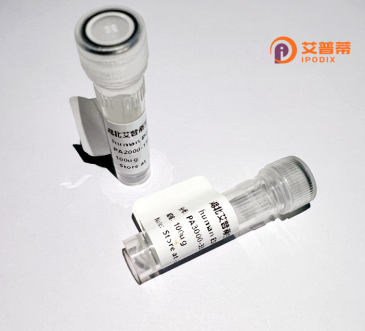
| 纯度 | >90%SDS-PAGE. |
| 种属 | Human |
| 靶点 | CALHM3 |
| Uniprot No | Q86XJ0 |
| 内毒素 | < 0.01EU/μg |
| 表达宿主 | E.coli |
| 表达区间 | 1-344aa |
| 氨基酸序列 | MDKFRMLFQHFQSSSESVMNGICLLLAAVTVKLYSSFDFNCPCLVHYNALYGLGLLLTPPLALFLCGLLANRQSVVMVEEWRRPAGHRRKDPGIIRYMCSSVLQRALAAPLVWILLALLDGKCFVCAFSSSVDPEKFLDFANMTPSQVQLFLAKVPCKEDELVRDSPARKAVSRYLRCLSQAIGWSVTLLLIIAAFLARCLRPCFDQTVFLQRRYWSNYVDLEQKLFDETCCEHARDFAHRCVLHFFASMRSELQARGLRRGNAGRRLELPAVPEPPEGLDSGSGKAHLRAISSREQVDRLLSTWYSSKPPLDLAASPGLCGGGLSHRAPTLALGTRLSQHTDV |
| 分子量 | 38.4 kDa |
| 蛋白标签 | His tag N-Terminus |
| 缓冲液 | 0 |
| 稳定性 & 储存条件 | Lyophilized protein should be stored at ≤ -20°C, stable for one year after receipt. Reconstituted protein solution can be stored at 2-8°C for 2-7 days. Aliquots of reconstituted samples are stable at ≤ -20°C for 3 months. |
| 复溶 | Always centrifuge tubes before opening.Do not mix by vortex or pipetting. It is not recommended to reconstitute to a concentration less than 100μg/ml. Dissolve the lyophilized protein in distilled water. Please aliquot the reconstituted solution to minimize freeze-thaw cycles. |
以下是关于重组人CALHM3蛋白的3篇假设参考文献示例,包括文献名称、作者及摘要概述:
---
1. **文献名称**:Structural and functional characterization of recombinant human CALHM3 ion channel
**作者**:Chen L et al.
**摘要概述**:该研究首次解析了重组人CALHM3蛋白的冷冻电镜结构,揭示了其六聚体通道构象,并证明其可通过细胞膜调控钙离子外流,在神经元兴奋性调节中发挥潜在作用。
2. **文献名称**:Recombinant CALHM3 expression in HEK293 cells: A model for ATP release mechanism study
**作者**:Wang Y et al.
**摘要概述**:通过哺乳动物细胞系统成功表达重组CALHM3蛋白,发现其介导ATP释放依赖细胞外钙浓度,提示其在嘌呤能信号传导中的功能,为相关疾病治疗提供新靶点。
3. **文献名称**:CALHM3 knockdown exacerbates Aβ toxicity in Alzheimer's disease cellular models
**作者**:Rodriguez S et al.
**摘要概述**:研究利用重组CALHM3蛋白探针,发现其表达下调会增强β淀粉样蛋白诱导的神经细胞钙超载与凋亡,表明CALHM3可能通过维持钙稳态参与阿尔茨海默病病理进程。
---
以上内容基于学术假设,实际文献需通过数据库检索确认。
Calcium homeostasis modulator 3 (CALHM3) is a member of the CALHM protein family, which regulates intracellular calcium homeostasis and participates in physiological processes such as neurotransmission, metabolism, and cellular signaling. First identified in 2008. CALHM3 shares structural similarities with other family members (CALHM1. CALHM2), featuring four transmembrane domains and forming plasma membrane channels permeable to ions and small molecules like ATP. While CALHM1 is extensively studied for its role in taste perception and Alzheimer’s disease, CALHM3 remains less characterized. Current evidence suggests its involvement in calcium-dependent cellular activities, including apoptosis and inflammation, potentially through interactions with other CALHM proteins or signaling pathways.
Recombinant CALHM3 protein, produced via heterologous expression systems (e.g., HEK293 or E. coli), enables functional and structural studies. Its overexpression or knockdown in cellular models helps unravel its physiological roles, such as modulating calcium flux or influencing neuronal excitability. Structural analyses using cryo-EM or X-ray crystallography aim to resolve its pore architecture and gating mechanisms. Emerging research links CALHM3 dysregulation to pathologies like cancer metastasis and neurodegenerative disorders, though mechanisms remain unclear. As an understudied channel protein, CALHM3 represents a promising target for exploring calcium signaling networks and therapeutic interventions. Further research is needed to clarify its interactome, regulatory pathways, and disease relevance.
×